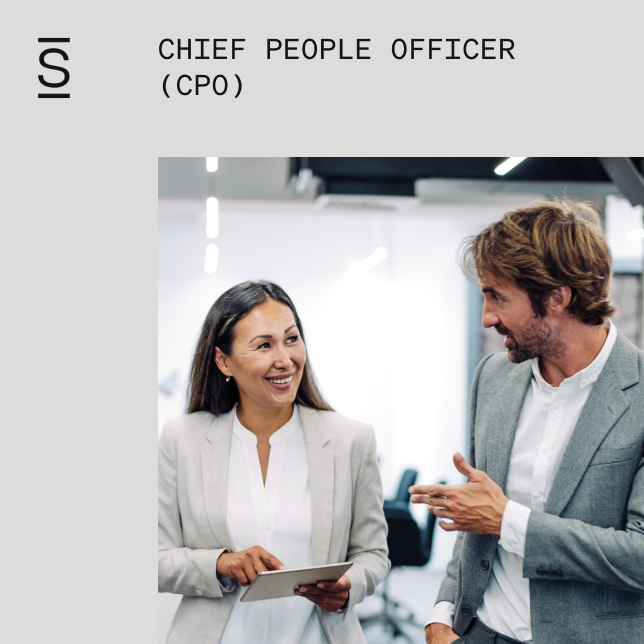Definition of Chief People Officer
A chief people officer (CPO) is an executive-level position that is responsible for overseeing and managing the operations and initiatives that impact employee experience and company culture. The CPO’s role lies in shaping the company’s people strategy, including talent acquisition, employee engagement, leadership development, and training programs. They are also responsible for establishing and maintaining on- and offboarding strategies, refining recruitment policies, and managing employee benefit programs.
Chief people officers work closely with the CEO and other company leaders to develop and implement initiatives that support the personal needs and professional growth of employees. The CPO acts as a liaison between the CEO, department heads, and employees, ensuring that the company’s people-related policies and practices align with its overall goals and values.

The job description of a chief people officer
The job of a chief people officer is multi-faceted and challenging. Job description responsibilities may include developing and executing strategies to enhance employee engagement, attract top talent, and promote a positive work culture. With the right qualifications and skills, a CPO can make a significant impact on the success of an organization by ensuring that its people truly are its greatest asset.
What does a chief people officer do?
The primary role of a chief people officer is to develop and implement strategies that enhance employee experience and engagement within an organization. They manage teams responsible for talent acquisition, corporate culture, onboarding/offboarding processes, and other aspects of human resources. CPOs also influence compensation plans and workplace policies that support employee well-being. They gather feedback on employee wellness and productivity to inform culture strategies and help develop succession planning. Additionally, CPOs oversee company-wide communication with employees and manage employee benefit programs.
Understanding the connection between the CEO and the CPO
The chief people officer collaborates with the CEO and other executives to maintain hiring and employee engagement strategies. They work closely with the CEO to align the company’s people strategy with its overall business goals and objectives. By understanding the CEO’s vision for the organization, the CPO can implement initiatives that support the company’s mission and values while fostering a positive work environment. The CPO acts as a trusted advisor to the CEO, providing insights on people-related matters and helping shape the company’s culture.
Responsibilities of a CPO
At a high level, here are some of the key responsibilities of a chief people officer:
- Shape and drive people strategy at a corporate level, including hiring practices, leadership development, and other training programs.
- Establish and maintain on- and offboarding strategies to ensure a smooth transition for employees.
- Refine recruitment policies to attract and retain top talent.
- Gather feedback on employee experience and engagement to inform culture strategies and initiatives.
- Help develop succession planning to ensure a strong pipeline of future leaders.
- Oversee company-wide communication with employees to ensure transparency and alignment.
- Manage employee benefit programs to support the well-being and satisfaction of employees.
Day-to-day tasks of a CPO
Like many professionals, a CPO starts their day early, often reviewing emails and catching up on any urgent matters. The morning may be dedicated to strategic planning, collaborating with the executive team to establish and execute human resources initiatives aligned with the company’s strategic objectives. A CPO might then spend the afternoon on more tactical objectives, developing or revising policies, programs, and processes that promote employee engagement, talent acquisition, and retention.
Common challenges encountered by chief people officers
The role of a chief people officer (CPO) comes with many challenges, primarily the task of balancing the needs and interests of employees against the goals and objectives of the organization. This requires a delicate approach to ensure that employees feel valued and supported while also driving the company forward.
Here are some of the specific challenges CPOs often face:
Resolving conflicts. CPOs often face the challenge of managing and resolving conflicts within teams and departments, fostering a harmonious and productive work environment.
Keeping up with regulations. Another challenge is aligning HR policies and practices with ever-changing laws and regulations, staying compliant while also meeting the needs of the workforce.
Equity, diversity, and inclusion (EDI). Navigating and managing cultural differences and diversity within the workforce is another crucial aspect of creating an inclusive environment.
Internal communications. Effective communication and engagement across all levels of the organization are vital for the success of a CPO, promoting transparency and collaboration.
Adapting to new technologies. Furthermore, CPOs must adapt to the evolving nature of work, considering the expectations and dynamics of a multi-generational workforce.
Change management. Lastly, overcoming resistance to change and implementing new initiatives can be a major hurdle, requiring strong leadership and persuasion skills.
Skills required for a chief people officer
To excel in the role and navigate the challenges listed above, a CPO needs to possess a diverse range of skills and qualities. Excellent communication and interpersonal skills are essential, as the CPO will collaborate with and influence stakeholders at all levels of the organization. Strong leadership and strategic thinking abilities are also important, as the CPO must navigate complex organizational challenges and drive transformative change. Additionally, a deep understanding of talent management, employee engagement, and organizational development is necessary to effectively develop and execute people-oriented strategies.
Indispensable skills for a CPO
The role of a chief people officer requires a combination of hard and soft skills. Hard skills include HR management expertise, knowledge of labor laws, and strategic workforce planning. Soft skills include leadership and communication, as well as interpersonal and problem-solving abilities. A successful CPO must have a comprehensive skill set to effectively manage and develop an organization’s human resources.
Examples of chief people officer hard skills
- Extensive knowledge of relevant statutes and regulations in labor and employment law.
- Business acumen and financial budget planning skills for hiring and compensation strategies.
- Ability to evaluate and make recommendations on all aspects of people management systems.
- Proficiency in using HR software tools, such as employee engagement platforms and applicant tracking systems.
- Familiarity with industry trends and regulatory requirements.
Examples of chief people officer soft skills
- Excellent communication and interpersonal skills to foster strong relationships with employees at all levels.
- Strong leadership and management abilities to effectively oversee and guide HR teams.
- Empathy and emotional intelligence to understand and address the needs and concerns of employees.
- Problem-solving and conflict-resolution skills to navigate and resolve various issues within the organization.
- Adaptability to navigate and respond to changing business and employee needs.
Chief people officer certificates and courses
Chief people officers usually work their way up through the ranks of human resources divisions, either within a single organization or, more commonly, across several different companies as they take on new roles of increasing responsibility. To qualify for the role of chief people officer, applicants are often expected to hold an MBA or other relevant master’s degree. In addition, advanced certificates in the field of HR can show a commitment to continuous learning and career development.
Organization and culture
The role of a chief people officer is extremely important in shaping the organization’s culture and ensuring that it aligns with the company’s values, mission, and goals. They are responsible for fostering an inclusive and diverse work environment where employees feel valued, respected, and motivated to perform their best.

How can a chief people officer create a positive work environment?
The chief people officer sets the tone for a positive work environment through a wide variety of initiatives, such as:
- Open communication
- Employee recognition programs
- Wellness programs
- Professional development programs
- Employee feedback
A corporate intranet is one of a CPO’s most valuable tools, helping them implement each of these initiatives and more.
Open communication. Promoting open and transparent communication encourages employees to express thoughts and ideas freely, fostering collaboration and teamwork. A modern intranet makes the job of managing internal communications infinitely easier, especially across large, enterprise organizations of thousands of employees.
Employee recognition programs. Implementing employee recognition and reward programs inspires a culture of appreciation and motivates individuals to perform at their best. Modern intranets like Simpplr include ready-to-go recognition and rewards programs that can quickly and easily be implemented at scale.
Wellness programs. Prioritizing employee well-being and work-life balance through initiatives such as flexible work schedules and wellness programs ensures that employees feel supported and valued. When an intranet platform comes with anAI virtual assistant that can communicate naturally with employees—across multiple languages—the process of administering these programs becomes as easy as talking.
Professional development programs. Providing opportunities for professional development and growth contributes to employees’ happiness and engagement in their roles. Intranets help today’s CPOs manage professional development programs at scale, providing meaningful opportunities for development and advancement across countless departments, functions, levels, and time zones.
Employee feedback. By encouraging and supporting employee feedback and engagement, the chief people officer facilitates a sense of ownership and involvement within the organization. A modern intranet platform can include survey functionality as well as multiple integrations with popular communications platforms, offering a wide variety of ways to encourage and collect employee feedback.
Helpful resources for HR professionals
These helpful resources for HR professionals can help build an amazing employee experience through meaningful culture, connections, and communications.
Simpplr can help align your teams and elevate your employee experience. See how in a 5-minute demo video today.

Watch a 5-minute demo
See how the Simpplr employee experience platform connects, engages and empowers your workforce.
- #1 Leader in the Gartner Magic Quadrant™
- 90%+ Employee adoption rate







